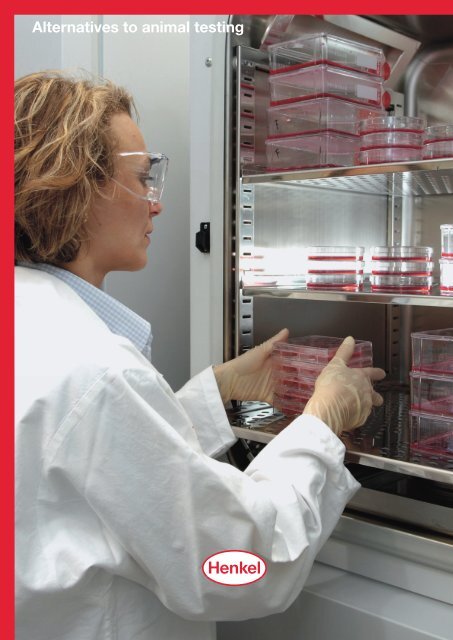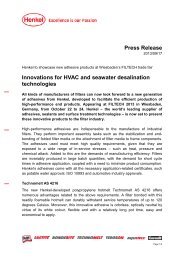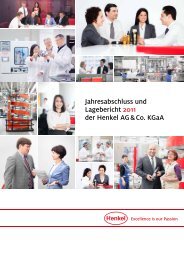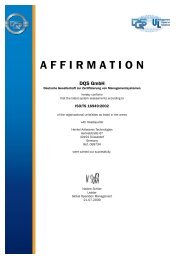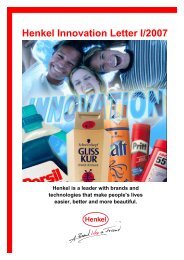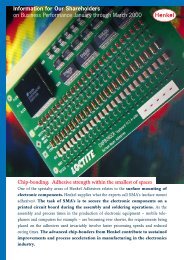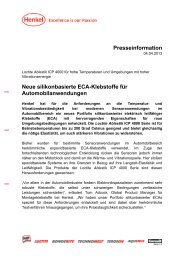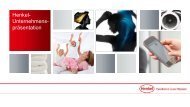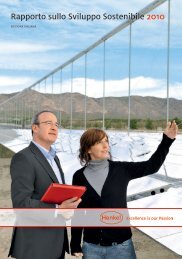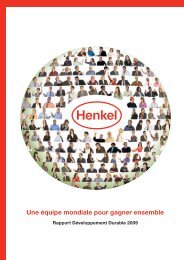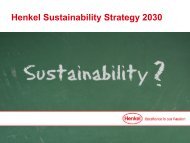Henkel: Alternatives to animal testing
Henkel: Alternatives to animal testing
Henkel: Alternatives to animal testing
You also want an ePaper? Increase the reach of your titles
YUMPU automatically turns print PDFs into web optimized ePapers that Google loves.
<strong>Alternatives</strong> <strong>to</strong> <strong>animal</strong> <strong>testing</strong><br />
<strong>Alternatives</strong> <strong>to</strong> <strong>animal</strong> <strong>testing</strong><br />
1
Contents<br />
Our commitment 3<br />
Safety and compatibility of all <strong>Henkel</strong> products<br />
Our responsibility 4<br />
Toward humans, <strong>animal</strong>s and the environment<br />
Our aim 5<br />
Alternative test methods<br />
Scientific approaches<br />
Official approval<br />
Our activities 9<br />
Cooperation with external partners – development, validation and<br />
approval of alternative test methods<br />
Scientists from <strong>Henkel</strong><br />
develop, promote and<br />
use alternative methods<br />
<strong>to</strong> <strong>animal</strong> <strong>testing</strong>.<br />
2 <strong>Alternatives</strong> <strong>to</strong> <strong>animal</strong> <strong>testing</strong>
Our commitment<br />
Safety and compatibility of all <strong>Henkel</strong> products<br />
<strong>Henkel</strong> is responsible for safety, health and environmental matters relating <strong>to</strong> the production, distribution<br />
and use of its products. Cus<strong>to</strong>mers and consumers can be sure that <strong>Henkel</strong> products and technologies have<br />
been extensively tested for compatibility with human health and the environment and are safe when used as<br />
intended.<br />
<strong>Henkel</strong> systematically evaluates the possible risks of new products during the research and development<br />
process. Raw materials and finished products are subjected <strong>to</strong> the required tests and assessments before they<br />
reach the market.<br />
<strong>Henkel</strong> only commissions <strong>animal</strong> <strong>testing</strong> if legislation so provides and no alternative test methods are<br />
available for obtaining the necessary safety data. Developing test methods that make no use of <strong>animal</strong>s and<br />
making these test methods generally available is a <strong>to</strong>p priority at <strong>Henkel</strong>. Since 2006, <strong>Henkel</strong> has considerably<br />
intensified its research concerning alternatives <strong>to</strong> <strong>animal</strong> <strong>testing</strong>. Here, an interdisciplinary team of<br />
experts works <strong>to</strong> develop test methods that are needed worldwide for the replacement of <strong>animal</strong> tests. At<br />
<strong>Henkel</strong>, these research capabilities are supported by expert knowledge of the effects of raw materials and<br />
products on skin and hair.<br />
<strong>Alternatives</strong> <strong>to</strong> <strong>animal</strong> <strong>testing</strong><br />
3
Our responsibility<br />
Toward humans, <strong>animal</strong>s and the environment<br />
As long as safety data obtained from <strong>animal</strong> <strong>testing</strong> are indispensable for an intended purpose,<br />
<strong>Henkel</strong> will take precautions <strong>to</strong> ensure that the number of tests is kept <strong>to</strong> a minimum.<br />
The following aspects in particular are carefully examined before commissioning any tests:<br />
• What are the legal requirements for ingredients or products?<br />
• Are applicable safety data available for the intended purpose?<br />
• Are alternatives <strong>to</strong> <strong>animal</strong> <strong>testing</strong> available and can they be used for safety assessments?<br />
If these checks reveal that an <strong>animal</strong> test cannot be avoided, <strong>Henkel</strong> ensures that the 3Rs principle will<br />
be applied. The 3Rs stand for refine, reduce, and replace. They relate <strong>to</strong> the development of test methods and<br />
the use of <strong>animal</strong> <strong>testing</strong>. The aim is <strong>to</strong> refine <strong>animal</strong> use so that test <strong>animal</strong>s are subjected <strong>to</strong> a minimum<br />
of stress, <strong>to</strong> reduce <strong>animal</strong> use by carrying out <strong>testing</strong> systematically and referring <strong>to</strong> already existing information,<br />
and – <strong>Henkel</strong>’s aim – <strong>to</strong> replace <strong>animal</strong> use by developing and using alternative research and test<br />
methods that make <strong>animal</strong> <strong>testing</strong> unnecessary.<br />
<strong>Henkel</strong> itself does not carry out any <strong>animal</strong> <strong>testing</strong>. Before it commissions any necessary tests by an audited<br />
external research institute, <strong>Henkel</strong> always checks whether the institute can carry out the requested tests<br />
in a manner that satisfies all legal requirements and is in line with our commitment and responsibility. The<br />
key criteria are conformity with recognized pro<strong>to</strong>cols, such as the test guidelines of the Organisation for Economic<br />
Co-operation and Development (OECD) and the principles of good labora<strong>to</strong>ry practice (GLP), and with<br />
the standards and country-specific regulations referred <strong>to</strong> in the EU Directive on the Protection of Animals.<br />
Product<br />
moni<strong>to</strong>ring<br />
in the<br />
market<br />
4 <strong>Alternatives</strong> <strong>to</strong> <strong>animal</strong> <strong>testing</strong><br />
Research<br />
and<br />
product<br />
development<br />
Internal<br />
auditing<br />
and corrective<br />
action<br />
Specification<br />
of<br />
precautionary measures<br />
Assessment<br />
of safety for<br />
people and the<br />
environment<br />
Implementation of<br />
product safety<br />
Regular audits are carried out <strong>to</strong><br />
verify compliance with corporate<br />
product safety requirements and<br />
procedures. The business sec<strong>to</strong>rs<br />
are responsible for the implementation<br />
of product safety.
Our aim<br />
Alternative test methods<br />
For <strong>Henkel</strong>, the aim of replacing <strong>animal</strong> <strong>testing</strong> by alternative test methods is of prime importance. We have<br />
been researching alternatives <strong>to</strong> <strong>animal</strong> <strong>testing</strong> methods since the early 1980s, both internally through our<br />
research and product safety departments and in cooperation with external research institutions. Although<br />
these efforts over the years have produced a number of successful results, a great deal still needs <strong>to</strong> be done<br />
before it will be possible <strong>to</strong> eliminate <strong>animal</strong> <strong>testing</strong> completely. This will require consistent use of the most<br />
advanced research methods in the areas of molecular biology and computer technologies.<br />
<strong>Henkel</strong> has therefore consolidated its activities for developing alternatives <strong>to</strong> <strong>animal</strong> <strong>testing</strong>. <strong>Henkel</strong> aims<br />
<strong>to</strong> develop additional alternative test methods on the basis of, for example, the Phenion® Full Thickness Skin<br />
Model (see box). <strong>Henkel</strong> works on alternative methods in joint projects as part of an international network<br />
comprising external industrial partners, government agencies and research establishments.<br />
The Phenion ® Full<br />
Thickness Skin Model<br />
<strong>Henkel</strong> has developed a robust<br />
full thickness skin model<br />
based on human cells. It can<br />
be produced <strong>to</strong> a constant<br />
and very high level of quality.<br />
A test substance is applied <strong>to</strong><br />
the Phenion ® Full Thickness<br />
Skin Model so that its effect<br />
on the skin tissue can be<br />
systematically evaluated. The<br />
substance, e.g. a cream formulation,<br />
is applied <strong>to</strong>pically using a brush. This can be done several times over a period of at least<br />
nine days. In this way, the effect of the substance on the cell layers in the skin can be studied. The<br />
standardized production of the model, in combination with its special properties, make it suitable for<br />
use as an in-vitro alternative <strong>to</strong> <strong>animal</strong> <strong>testing</strong>.<br />
<strong>Alternatives</strong> <strong>to</strong> <strong>animal</strong> <strong>testing</strong><br />
5
Our aim<br />
Scientific approaches<br />
Important approaches include:<br />
• the development of in-vitro (in the glass) methods based on biological materials (for example,<br />
skin or other human body cells) that will be suitable for reliably verifying the safety and<br />
compatibility of product ingredients;<br />
• the development of in-silico (in the computer) methods <strong>to</strong> determine the compatibility of<br />
substances on the basis of their chemical structure.<br />
In-vitro methods<br />
Instead of using <strong>animal</strong>s, cell and tissue cultures<br />
can be used <strong>to</strong> test product ingredients.<br />
Cell culture experiments can show, for example,<br />
the lowest concentration at which an ingredient<br />
causes damage <strong>to</strong> cells. The results enable<br />
conclusions <strong>to</strong> be drawn about the ingredient’s<br />
compatibility with tissue. Cell cultures are now<br />
also used routinely <strong>to</strong> test substances for mutagenic<br />
properties.<br />
Tissue cultures are additionally used <strong>to</strong> test<br />
substances for compatibility with mucous membranes.<br />
A familiar example is the Hen’s Egg Test,<br />
which <strong>Henkel</strong> scientists are now further developing<br />
so that it can be used <strong>to</strong> test for mutagenic<br />
properties as well.<br />
In-vitro test system for the investigation of substance<br />
penetration through the skin.<br />
6 <strong>Alternatives</strong> <strong>to</strong> <strong>animal</strong> <strong>testing</strong><br />
In-silico methods<br />
Substances with similar chemical structures<br />
often have similar properties. In these cases,<br />
therefore, a knowledge of the properties of a few<br />
representative substances is sufficient <strong>to</strong> be able<br />
<strong>to</strong> deduce the properties of a series of similar<br />
substances. By analogy, certain properties of<br />
these representative substances can also be assumed<br />
<strong>to</strong> be properties of the other substances<br />
in the series. The required calculations are<br />
performed using specially developed computer<br />
programs. It is anticipated that combinations of<br />
such calculations will make it possible <strong>to</strong> narrow<br />
down the number of substances <strong>to</strong> be tested.<br />
Only these selected substances will then have<br />
<strong>to</strong> be tested according <strong>to</strong> the legally prescribed<br />
test methods.<br />
In-silico methods gain more and more relevance for the<br />
development of alternatives <strong>to</strong> <strong>animal</strong> <strong>testing</strong>.
Research in<strong>to</strong> alternative test methods has so far resulted in the incorporation of a range of new cell and<br />
tissue culture systems in<strong>to</strong> the reper<strong>to</strong>ire of alternative methods. These methods are used <strong>to</strong> investigate the<br />
behavior of a substance in the body or its effect on skin and mucous membranes. A single-layer epidermis<br />
skin model was included in the OECD guidelines several years ago as a method for <strong>testing</strong> skin irritating<br />
properties (see “Alternative test methods” box). Recently, a similar skin model has been approved by the<br />
European Centre for the Validation of Alternative Methods (ECVAM) for <strong>testing</strong> for inflamma<strong>to</strong>ry properties.<br />
<strong>Henkel</strong> and other companies and institutions are working intensively <strong>to</strong> speed up the development of<br />
additional valid alternative methods and intelligent test strategies for reducing and replacing <strong>animal</strong><br />
<strong>testing</strong>.<br />
Alternative test methods<br />
At present there are only seven alternative methods that can replace legally required tests on <strong>animal</strong>s.<br />
The following have been validated and given regula<strong>to</strong>ry approval:<br />
• tests for corrosive properties (OECD 430 and 431),<br />
• tests for acute pho<strong>to</strong><strong>to</strong>xicity or irritation (OECD 432),<br />
• tests for skin absorption (OECD 428), and<br />
• in-vitro methods for determining potentially mutagenic effects (OECD 471, 473, 476).<br />
Further methods are in the validation phase (see http://ecvam.jrc.it).<br />
The Local Lymph Node Assay (LLNA), which has been approved by the OECD as a test for skinsensitizing<br />
properties (OECD 429), makes an important contribution <strong>to</strong> refinement and reduction.<br />
The number of <strong>animal</strong>s needed for certain tests was also reduced by the harmonization of test<br />
requirements and the development of new test methods, such as the Acute Toxic Class Method<br />
(OECD 423) and the Fixed Dose Method (OECD 420) for <strong>testing</strong> for acute oral <strong>to</strong>xicity. The industry<br />
played a decisive role in the development of the test pro<strong>to</strong>cols.<br />
<strong>Alternatives</strong> <strong>to</strong> <strong>animal</strong> <strong>testing</strong><br />
7
Our aim<br />
Official approval<br />
When an alternative method is developed, it must undergo an internationally recognized validation process<br />
before being officially approved. This procedure is very complicated and usually takes more than ten years.<br />
The alternative methods developed must first be subjected <strong>to</strong> comparative tests in a number of labora<strong>to</strong>ries<br />
(round-robin studies) <strong>to</strong> demonstrate that the results obtained carry as much weight as those of in-vivo<br />
studies, so that the alternative method provides an equivalent level of safety. The results of these studies<br />
are submitted <strong>to</strong> the responsible scientific committee of the European Centre for the Validation of Alternative<br />
Methods (ECVAM) for evaluation. Once the validity of the method has been recognized by ECVAM, the<br />
Organisation for Economic Co-operation and Development (OECD) can then officially approve the alternative<br />
method and incorporate it in<strong>to</strong> an OECD guideline.<br />
8 <strong>Alternatives</strong> <strong>to</strong> <strong>animal</strong> <strong>testing</strong><br />
Selected non-<strong>animal</strong> screening and alternative<br />
methods used in <strong>Henkel</strong> labora<strong>to</strong>ries:<br />
• Neutral red cy<strong>to</strong><strong>to</strong>xicity assay for determining cell<br />
<strong>to</strong>xicity potential,<br />
• Organotypical skin models for studying irritation of<br />
the skin,<br />
• Hen’s Egg Test for mucous membrane compati-<br />
bility (Hen’s Egg Test on the Chorionallan<strong>to</strong>ic<br />
Mem brane, HET-CAM Test),<br />
• In-vitro <strong>testing</strong> of skin absorption (OECD 428),<br />
• Pho<strong>to</strong>hemolysis test for determining pho<strong>to</strong><strong>to</strong>xic<br />
potential,<br />
• Dendritic cells for determining sensitizing<br />
potential,<br />
• In-silico methods: quantitative structure-activity<br />
relationships using chemical informatics systems
Our activities<br />
Cooperation with external partners – development, validation<br />
and approval of alternative test methods<br />
<strong>Henkel</strong> actively promotes and participates in cross-industry programs for developing non-<strong>animal</strong> test methods.<br />
<strong>Henkel</strong> is a member of the European Partnership for Alternative Approaches <strong>to</strong> Animal Testing (EPAA, see<br />
below) and of various committees of the European Cosmetic Toiletry and Perfumery Association (COLIPA)<br />
focusing on alternatives <strong>to</strong> <strong>animal</strong> <strong>testing</strong>. In addition, <strong>Henkel</strong> collaborates with partner companies and<br />
government agencies in carrying out validation projects <strong>to</strong> smooth the way for official acceptance of newly<br />
developed methods. <strong>Henkel</strong> also plays a role in organizations that promote alternative methods, such as<br />
the German Foundation for the Promotion of Alternative and Complementary Methods <strong>to</strong> Reduce Animal<br />
Testing (SET), and represents the chemical industry on the Commission of the German Centre for Documentation<br />
and Evaluation of <strong>Alternatives</strong> <strong>to</strong> Animal Experiments (ZEBET).<br />
European Partnership for Alternative<br />
Approaches <strong>to</strong> Animal Testing<br />
In November 2005, the European Partnership<br />
for Alternative Approaches <strong>to</strong> Animal Testing<br />
(EPAA) was launched by the European Commission<br />
and industry. The chemical, plant<br />
protection, pharmaceutical, cosmetics, detergent<br />
and household cleaner, and biotechnology<br />
sec<strong>to</strong>rs are represented in the initiative.<br />
<strong>Alternatives</strong> <strong>to</strong> <strong>animal</strong> <strong>testing</strong><br />
9
In the Brussels 3Rs Declaration <strong>Henkel</strong>, <strong>to</strong>gether with the other partners, has committed <strong>to</strong> refining, reducing<br />
and ultimately replacing the use of <strong>animal</strong>s. In early 2006, the European Partnership formulated an<br />
action program which is now being implemented by the participating parties. <strong>Henkel</strong> has been actively<br />
involved in developing and implementing the activities of the European Partnership from the very beginning.<br />
The Partnership announces the results of its joint efforts in a progress report at its annual conference.<br />
Legal requirements in the European Union<br />
As stipulated in the EU Cosmetics Directive, cosmetic products must satisfy especially stringent<br />
requirements regarding consumer safety and health compatibility. Since 2004, <strong>animal</strong> <strong>testing</strong> has<br />
been banned throughout the EU for finished cosmetic products. Effective March 2009, this ban<br />
is now being extended <strong>to</strong> cosmetic ingredients as well. According <strong>to</strong> the 7th Amendment <strong>to</strong> the<br />
EU Cosm etics Directive of 27 February 2003, <strong>animal</strong> <strong>testing</strong> may no longer be performed in the EU<br />
after mid-March 2009 for cosmetic ingredients. Our researchers and product developers are already<br />
prepared for the changes now coming in<strong>to</strong> effect.<br />
With its new chemicals legislation REACH, the European Union requires all chemicals <strong>to</strong> be newly<br />
registered, evaluated and – where necessary – authorized (REACH = Registration, Evaluation, and<br />
Authorization of Chemicals). To prevent that this registration process leads <strong>to</strong> a dramatic increase<br />
in the number of tests on <strong>animal</strong>s, suitable alternative methods must soon be made available and<br />
officially approved.<br />
10 <strong>Alternatives</strong> <strong>to</strong> <strong>animal</strong> <strong>testing</strong>
Credits / Contacts<br />
<strong>Henkel</strong> AG & Co. KGaA, 40191 Düsseldorf, Germany<br />
© <strong>Henkel</strong> 2009<br />
Corporate Communications<br />
Dr. Ute Krupp<br />
Phone: +49-211-797-5641<br />
Fax: +49-211-798-15641<br />
E-mail: ute.krupp@henkel.com<br />
Internet: www.henkel.com<br />
Further information on alternative test methods<br />
Biological and Clinical Research<br />
Dr. Claudia Hundeiker<br />
Phone: +49-211-797-7478<br />
Fax: +49-211-798-7887<br />
E-mail: claudia.hundeiker@henkel.com<br />
Internet: www.henkel.com<br />
Pho<strong>to</strong>s: <strong>Henkel</strong><br />
PR-No.: 03 09 000<br />
Responsible Care ®<br />
The FSC logo identifies products which contain wood<br />
from well managed forests independently certified<br />
in accordance with the strict rules of the Forest<br />
Stewardship Council. This publication was print ed<br />
on Profisilk FSC from Sappi.<br />
<strong>Alternatives</strong> <strong>to</strong> <strong>animal</strong> <strong>testing</strong><br />
11
12 <strong>Alternatives</strong> <strong>to</strong> <strong>animal</strong> <strong>testing</strong>


